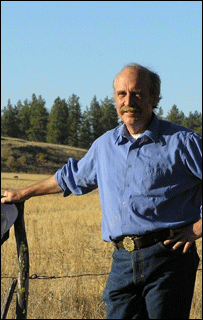What I Learned from John Keeble
I attended the University of Alabama’s MFA program between 1991-1995. During that period, I took two workshops with writer John Keeble, a visiting writer who taught at Eastern Washington University. He made a great impression on both my writing and my teaching.
In fact, the title of this blog, “The Big Thing,” comes from Keeble. I wrote about that here, and how I might not have written The Circus in Winter had he not changed the default setting of a pivotal workshop.
Here’s something else I learned from him.
Plant the Seed of Your Story
In workshop, Keeble talked to us a lot about “planting the seed of your story.” Once you figure out what your story is really about, you have to return to the the first page, the first paragraph, the first sentence! and plant the story’s “seed” that you will nurture and grow for the next 5-30 pages.
 Consider, for example, the first sentence of Tim O’Brien’s story “The Things They Carried.”
Consider, for example, the first sentence of Tim O’Brien’s story “The Things They Carried.”
First Lieutenant Jimmy Cross carried letters from a girl named Martha, a junior at Mount Sebastian College in New Jersey.
So many dramatic questions are introduced in that sentence–who is Jimmy Cross, who is Martha, why does he carry these letters? what will be the ramifications of his doing so?–and by the end of the story, we’ll know the answers. That sentence contains the entire story. The way the war and duty pull him in one direction (“First Lieutenant,” not just “Jimmy Cross”) and home and love pull him in the opposite direction (she is not just “a girl” but “Martha,” a girl from a specific place).
Imagine if this story began instead with a scene between Jimmy and Ted Lavender? or with the list of what everyone in the unit carries? That would utterly change the way the story affects us as readers.
What I’ve learned since taking Keeble’s class is that a short story is a closed, complete narrative experience. Beginning. Middle. End. What makes a story “feel like” a story is what happens inside the reader’s brain, the internal satisfaction that comes with closure. In “Coming to Terms with the Short Story,” genre theorist Susan Lohafer offers the best definition of the short story I’ve ever found:
“Unlike longer fictions—even the most artful and word-conscious novels—short stories do not offer vicarious experience of a surrogate world. They haven’t the time. Rather, they put us through something…”
I think that a story gives us many, many things to think about–a whole hothouse conservatory of plants–but when we come to the end of a well-constructed story, we realize that we’ve been watching one particular plant all along, and we derive enjoyment from the totality of that experience.
 Watching a plant grow satisfies just like watching a child grow.
Watching a plant grow satisfies just like watching a child grow.
There’s a huge difference between being shown a plant and witnessing the course of its blooming–even if only in passing, in the middle of a busy, buzzing life.
So often, young writers begin a story in that hothouse conservatory, surrounded by possibilities. They plant a shit ton of seeds. They only discover what particular plant they’re really trying to grow at the end of writing their story.
But–don’t you see?–the way that a writer discovered that flower and what the reader needs in order to apprehend and appreciate that flower are two totally different things.
That’s what John Keeble taught me, and what I’ve tried to teach my students.


This is a brilliant post that I’m going to use with my beginning fiction class next semester.
Though I’ve followed what you’ve said about not letting the short story be the sole thing we teach — and have tried to apply techniques you’ve passed on about teaching the writing of big things — I find that I also need to prevent beginning students from wandering off into a picaresque wilderness of plot twists and never facing the challenges of trying to finish a story. For purposes of teaching my beginning class, I think this next time (unlike previous iterations) I’m going to say “I’m glad you’re working on a novel, but here you need to write a story you can hope to finish.” What’s in this post should help me to convey why. I look forward to seeing more of Susan Lohafer’s thinking.
Thank you Lowry!